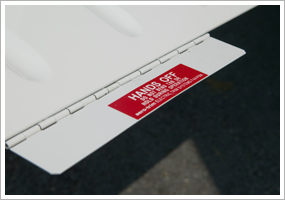| The following stories from the July 3, 2009, edition of AOPA ePilot were provided to AOPA members who expressed an interest in the particular subject areas. Any AOPA member can receive information tailored to their areas of interest by updating their preferences online. TRAINING TIPsTrainers and trim
Even if your cockpit only has an elevator-trim control, there may be another trim system built into the aircraft: a ground-adjustable rudder trim tab. Learn how to use it to correct out-of-trim conditions detectable by feel or shown on the inclinometer. See the June 12 “ Training Tip: Step on the ball.”
Working with a ground-adjustable trim tab—and confirming that the adjustments did the trick—may take more than one try. “This tab is bent in one direction or the other while on the ground to apply a trim force to the rudder. The correct displacement is determined by trial-and-error process. Usually, small adjustments are necessary until you are satisfied that the airplane is no longer skidding left or right during normal cruising flight,” explains Chapter 4 of the Pilot’s Handbook of Aeronautical Knowledge .
At the other end of the spectrum, pilots training in highly automated machines such as technically advanced aircraft (TAA) know trim as one component of an integrated system. “The autopilot and trim systems are typically integrated because the autopilot uses the aircraft trim servos as the primary mechanical interface to the flight controls. Because the autopilot can compete with an unsuspecting pilot for control of the aircraft (by design the pilot must be able to win), it makes sense for the pilot to not only understand exactly how to operate the autopilot and the trim system, but also to completely check its operation prior to liftoff to make sure that it is fully functional,” wrote Michael G. Gaffney in the April 2007 AOPA Flight Training feature “ Glass Class: Meet your TAA.”
Whether you are moving up or just moving over, be sure to learn what your aircraft offers for trim control. TRAINING PRODUCTSResource library in an iPhone applicationStudent pilots looking for knowledge test studying on the go now have a resource for the iPhone and iPod touch. “PilotPrep” is an FAA knowledge test question bank for the sport pilot, private pilot, recreational pilot, and instrument airplane knowledge tests. Users can go through each question bank and take study exams while the program keeps track of the selected answers. The application is $6.99; download from the Web site. Note: Products listed have not been evaluated by ePilot editors unless otherwise noted. AOPA assumes no responsibility for products or services listed or for claims or actions by manufacturers or vendors. FINAL EXAMQuestion: My instructor and I are planning to fly from our home airport to Oshkosh this year for EAA AirVenture. We are concerned because a portion of our flight will take us over Canadian airspace. Do we need to comply with Customs and Border Protection’s eAPIS (Electronic Advance Passenger Information System)?
Answer: You will not need to submit an eAPIS passenger manifest. However, there are other requirements with which you must comply. Overflights that originate and end in the United States require that the pilot file and activate a VFR or IFR flight plan. Pilots should write “Canadian overflight—no landing” in the remarks section of the flight plan. The U.S. government requires a transponder be used to cross the U.S. border in either direction, inbound or outbound. You must also be in communication with a U.S. air traffic control agency before crossing the border. Sport and recreational pilots are not allowed to conduct this type of overflight operation without prior authorization because the certificate does not meet ICAO and Canadian rules. Find out more about international flying by reading “ eAPIS: Frequently Asked Questions” and by taking the AOPA Air Safety Foundation’s interactive course on eAPIS. Got a question for our technical services staff? E-mail to [email protected] or call the Pilot Information Center, 800/872-2672. Don't forget the online archive of "Final Exam" questions and answers, searchable by keyword or topic. |
 How many trim-control systems does your trainer possess? Are they manual or electric? Even different examples of the same make and model aircraft may offer different trim capabilities. Typically, a pilot first encounters differences when moving from an aircraft with basic elevator trim to one that also features a rudder-trim knob or wheel. An example is the Piper Warrior III, reviewed by Mark Twombly in his article on
How many trim-control systems does your trainer possess? Are they manual or electric? Even different examples of the same make and model aircraft may offer different trim capabilities. Typically, a pilot first encounters differences when moving from an aircraft with basic elevator trim to one that also features a rudder-trim knob or wheel. An example is the Piper Warrior III, reviewed by Mark Twombly in his article on 

